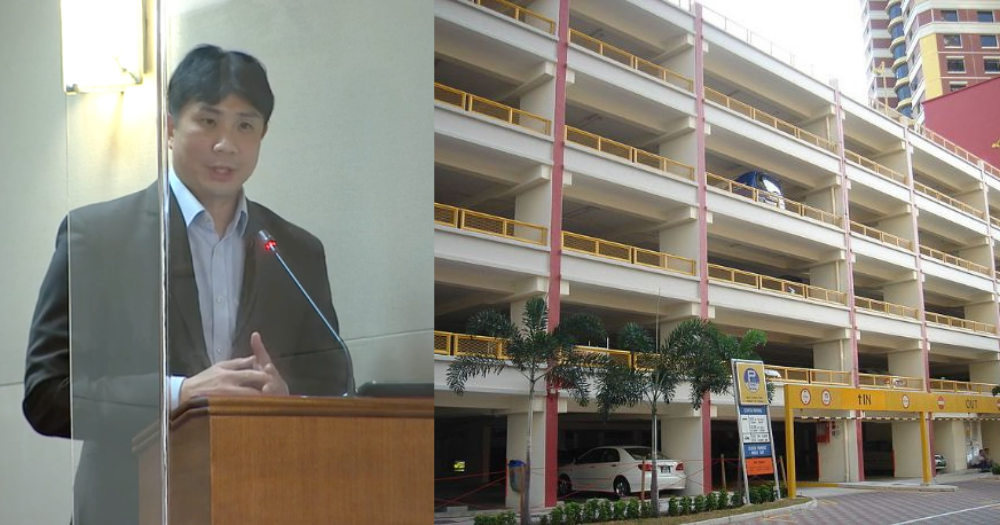Zhangxin Zheng
March 06, 2021

Sengkang GRC Member of Parliament Jamus Lim proposed that the under-utilised floors of the multi-storey carparks be converted into commercial uses during the Ministry of National Development's Committee of Supply Debates on Mar. 4.
Lim noticed that multi-storey carparks is a common feature in modern towns like Sengkang, which tend to be denser, with commercial spaces and similar amenities located in specific clusters.
Multistorey Carparks may be under-utilised
However, Lim noticed that the uppermost floors of a multi-storey carpark can sometimes be under-utilised.
He noted that this does not reflect on poor planning but the difficulty of forecasting parking space demand during the construction phase.
As Singapore strives towards a lower-carbon future, the demand for private transportation may fall even further, releasing more spaces in these multi-storey carparks.
Allow commercial uses in multistorey carparks
Therefore, Lim proposed that the Housing and Development Board (HDB) consider converting segments of the multistorey carparks to commercial uses.
There is precedent in the conversion of segments of the multi-storey carparks for uses beyond parking of vehicles.
Lim cited car wash bays, permits for car grooming and car sharing businesses, and Town Council office facilities as examples.
There are, however, no systematic schemes to permit the conversion of under-utilised multi-storey carpark spaces for other commercial uses.
Lim listed cafes, bubble-tea shops, or central kitchens as possible commercial uses that can be allowed to use empty spaces in the carpark.
Pros and cons
Enabling this conversion will allow businesses to locate closer to their customers, residents to have convenient employment opportunities and more nearby places to eat, shop and socialise, Lim said.
However, Lim recognises that there are limitations such as noise disturbances or the additional demand for electricity and exhaust management.
However, these are "surmountable challenges, Lim said.
Idea may not be suitable due to lack of pedestrian flow and visibility
In response, Senior Minister of State Sim Ann said that Lim's suggestion "may not be very suitable for commercial facilities, as retailers usually prefer locations with good pedestrian flow and visibility".
She said that the top decks of such carparks are typically landscaped and provided with recreational facilities like playgrounds, exercise areas, and community gardens instead.
She also noted that some can even be converted into urban farms.
Such landscaping also helps to reduce the urban heat island effect, she added.
Nonetheless, HDB makes sure to include enough commercial spaces in its estates, Sim said.
Top image via CNA video screengrab and wikimedia
Multistorey Carparks may be under-utilised
However, Lim noticed that the uppermost floors of a multi-storey carpark can sometimes be under-utilised.
He noted that this does not reflect on poor planning but the difficulty of forecasting parking space demand during the construction phase.
As Singapore strives towards a lower-carbon future, the demand for private transportation may fall even further, releasing more spaces in these multi-storey carparks.
Allow commercial uses in multistorey carparks
Therefore, Lim proposed that the Housing and Development Board (HDB) consider converting segments of the multistorey carparks to commercial uses.
There is precedent in the conversion of segments of the multi-storey carparks for uses beyond parking of vehicles.
Lim cited car wash bays, permits for car grooming and car sharing businesses, and Town Council office facilities as examples.
There are, however, no systematic schemes to permit the conversion of under-utilised multi-storey carpark spaces for other commercial uses.
Lim listed cafes, bubble-tea shops, or central kitchens as possible commercial uses that can be allowed to use empty spaces in the carpark.
Pros and cons
Enabling this conversion will allow businesses to locate closer to their customers, residents to have convenient employment opportunities and more nearby places to eat, shop and socialise, Lim said.
However, Lim recognises that there are limitations such as noise disturbances or the additional demand for electricity and exhaust management.
However, these are "surmountable challenges, Lim said.
Idea may not be suitable due to lack of pedestrian flow and visibility
In response, Senior Minister of State Sim Ann said that Lim's suggestion "may not be very suitable for commercial facilities, as retailers usually prefer locations with good pedestrian flow and visibility".
She said that the top decks of such carparks are typically landscaped and provided with recreational facilities like playgrounds, exercise areas, and community gardens instead.
She also noted that some can even be converted into urban farms.
Such landscaping also helps to reduce the urban heat island effect, she added.
Nonetheless, HDB makes sure to include enough commercial spaces in its estates, Sim said.
Top image via CNA video screengrab and wikimedia
No comments:
Post a Comment
Please note that this is a "news clipping" blog. Articles may have been authored elsewhere and "clipped" to this blog for ease of reference. The blog "owner" is usually not the author and does not have any means of relaying your comments or questions to the author or authors.
Comments that will drive discussion and explore issues may be kept. Other comments may be deleted.